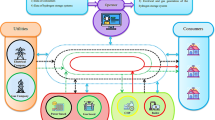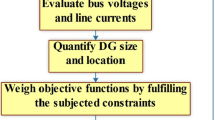Abstract
Electricity usage at electricity rush hour (peak hour) may vary from each and every service area such as industrial area, commercial area and residential area. Equalizing the power consumption in industry may lead to the utilization of power in other service areas in an efficient way. Although industries have comparably lesser number of power consuming device types than other service areas the power consumption is quite high. To meet the demands rising in the industry, shiftable loads (devices) can be redistributed equally to all the working time slots based on the average power utilization. It can be done in a flexible manner by shaping the loads using Demand Side Management (DSM) technique in Smart Grid. The main objective is to minimize the power utilization during the electricity rush hour by effectively distributing the power available during off-peak hour. Evolutionary algorithm can be well adapted to problems where optimization is the core criteria. Any maximization or minimization problem can be solved efficiently using evolutionary algorithm. Hence, to obtain the optimized fitness function of load redistribution in industry Genetic Algorithm in Demand Side Management (GA-DSM) is chosen and it has benefited with an overall reduction of 21.91% which is very remarkable. In addition to this the evaluation of the fitness function using GA-DSM is carried out in other two industrial dataset models (steel plant and wind power plant) which is unavailable so far in the literature.



















Similar content being viewed by others
References
Yi, W., & Dong, W. (2015). Modeling and simulation of discharging characteristics of external melt ice-on coil storage system. International Journal of Smart Home, 9(2), 179–192.
Basso, G., Gaud, N., Gechter, F., Hilarie, V., & Lauri, F. (2013). A framework for qualifying and evaluating Smart Grids approaches: Focus on multi-agent technologies. Smart Grid and Renewable Energy, 4, 333–347.
Li, Q., & Zhou, M. (2011). The future-oriented grid-Smart Grid. Journal of Computers, 6(1), 98–105.
Wissner, M. (2011). The Smart Grid–A saucerful of secrets? Applied Energy, 88(7), 2509–2518.
Wu, Y., Chen, J., & Liu, L. (2011). Construction of China’s Smart Grid information system analysis. Renewable and Sustainable Energy Reviews, 15(9), 4236–4241.
Bakker, V., Bosman, M. G. C., Molderink, A., Hurink, J. L., & Smit, G. J. M. (2010). Demand side load management using a three step optimization methodology. In Smart Grid Communications (SmartGridComm), First IEEE international conference, pp. 431–436.
Mahmood, A., Ullah, M. N., Razzaq, S., Basit, A., Mustafa, U., Naeem, M., et al. (2014). A new scheme for demand side management in future Smart Grid networks. Procedia Computer Science, 32, 477–484.
Gellings, C. W. (1985). The concept of demand-side management for electric utilities. Proceedings of the IEEE, 73(10), 1468–1470.
Sithara, N. N., & Saminathan, V. (2014). Optimal scheduling of ICT for demand side management in smart grid. International Journal of Advanced Research in Electrical, Electronics and Instrumentation Engineering, 3(4), 9187–9193.
Gellings, C. W., & Chamberlin, J. H. (1987). Demand-side management: Concepts and methods. Lilburn: Fairmont Press.
Maharjan, I. K. (2010). Demand side management: Load management, load profiling, load shifting, residential and industrial consumer, energy audit, reliability, urban, semi-urban and rural setting. Saarbrücken: LAP Lambert Academic Publication.
Kothari, D. P., & Nagrath, I. J. (2011). Modern power system analysis. New York: Tata McGraw-Hill Education.
Mohsenian-Rad, A. H., Wong, V. W., Jatskevich, J., Schober, R., & Leon-Garcia, A. (2010). Autonomous demand-side management based on game-theoretic energy consumption scheduling for the future smart grid. IEEE Transactions on Smart Grid, 1(3), 320–331.
Jayadev, V., & Swarup, K. S. (2013, October). Optimization of microgrid with demand side management using Genetic Algorithm. In IET conference on power in unity: A whole system approach, pp. 1–6.
Logenthiran, T., Srinivasan, D., & Shun, T. Z. (2012). Demand side management in smart grid using heuristic optimization. IEEE Transactions on Smart Grid, 3(3), 1244–1252.
Macedo, M. N. Q., Galo, J. J. M., De Almeida, L. A. L., & Lima, A. D. C. (2015). Demand side management using artificial neural networks in a Smart Grid environment. Renewable and Sustainable Energy Reviews, 41, 128–133.
Tsagarakis, G., Thomson, R. C., Collin, A. J., Harrison, G. P., Kiprakis, A. E., & McLaughlin, S. (2016). Assessment of the cost and environmental impact of residential demand-side management. IEEE Transactions on Industry Applications, 52(3), 2486–2495.
Adika, C. O., & Wang, L. (2014). Demand-side bidding strategy for residential energy management in a smart grid environment. IEEE Transactions on Smart Grid, 5(4), 1724–1733.
Liu, Y., Yuen, C., Huang, S., Hassan, N. U., Wang, X., & Xie, S. (2014). Peak-to-average ratio constrained demand-side management with consumer’s preference in residential Smart Grid. IEEE Journal of Selected Topics in Signal Processing, 8(6), 1084–1097.
Yao, E., Samadi, P., Wong, V. W., & Schober, R. (2016). Residential demand side management under high penetration of rooftop photovoltaic units. IEEE Transactions on Smart Grid, 7(3), 1597–1608.
Affonso, C. M., & da Silva, R. V. (2015). Demand side management of a residential system using simulated annealing. IEEE Latin America Transactions, 13(5), 1355–1360.
Agha, M. H., Thery, R., Hetreux, G., Hait, A., & Le Lann, J. M. (2010). Integrated production and utility system approach for optimizing industrial unit operations. Energy, 35(2), 611–627.
Samad, T., & Kiliccote, S. (2012). Smart grid technologies and applications for the industrial sector. Computers & Chemical Engineering, 47, 76–84.
Reka, S. S., & Ramesh, V. (2016). Industrial demand side response modelling in smart grid using stochastic optimisation considering refinery process. Energy and Buildings, 127, 84–94.
Zhang, X., Hug, G., Kolter, Z., & Harjunkoski, I. (2015). Industrial demand response by steel plants with spinning reserve provision. In North American Power Symposium (NAPS), pp. 1–6. IEEE.
Michalewicz, Z. (2013). Genetic algorithms + data structures = evolution programs. Berlin: Springer Science & Business Media.
Holland, J. H. (1992). Adaptation in natural and artificial systems: An introductory analysis with applications to biology, control, and artificial intelligence. Cambridge: MIT press.
Goldberg, D. E. (2006). Genetic algorithms. London: Pearson Education India.
Xu, J., Tan, S., & Panda, S. K. (2011). Optimization of economic load dispatch for a microgrid using evolutionary computation. IECON 2011-37th annual conference on IEEE industrial electronics society. IEEE, pp. 3192–3197.
Lee, K. Y., & El-Sharkawi, M. A. (Eds.). (2008). Modern heuristic optimization techniques: Theory and applications to power systems (Vol. 39). New York: Wiley.
Yadav, P. K., & Prajapati, N. L. (2012). An overview of genetic algorithm and modeling. International Journal of Scientific and Research Publications, 2(9), 1–4.
Author information
Authors and Affiliations
Corresponding author
Rights and permissions
About this article
Cite this article
Bharathi, C., Rekha, D. & Vijayakumar, V. Genetic Algorithm Based Demand Side Management for Smart Grid. Wireless Pers Commun 93, 481–502 (2017). https://doi.org/10.1007/s11277-017-3959-z
Published:
Issue Date:
DOI: https://doi.org/10.1007/s11277-017-3959-z




